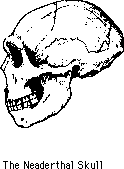

In 1856, a primitive-looking skull with massive bony ridges above the eye sockets came to light in a cave near Neanderthal, Germany. This strange skull aroused intense scholarly interest.
Some experts dismissed it as the remains of a pathological idiot, or of a wounded Cossack fleeing from Napoleon's armies. British biologist Thomas Huxley thought otherwise. Huxley realized he was looking at an early form of human being, perhaps an ancestor of anatomically modern people.
He posed what he called the "question of questions" -- the nature of the anatomical and evolutionary relationship between human beings and their closest living non-human primate relatives, the chimpanzees. Huxley was an eloquent writer, a champion of the Theory of Evolution and Natural Selection.